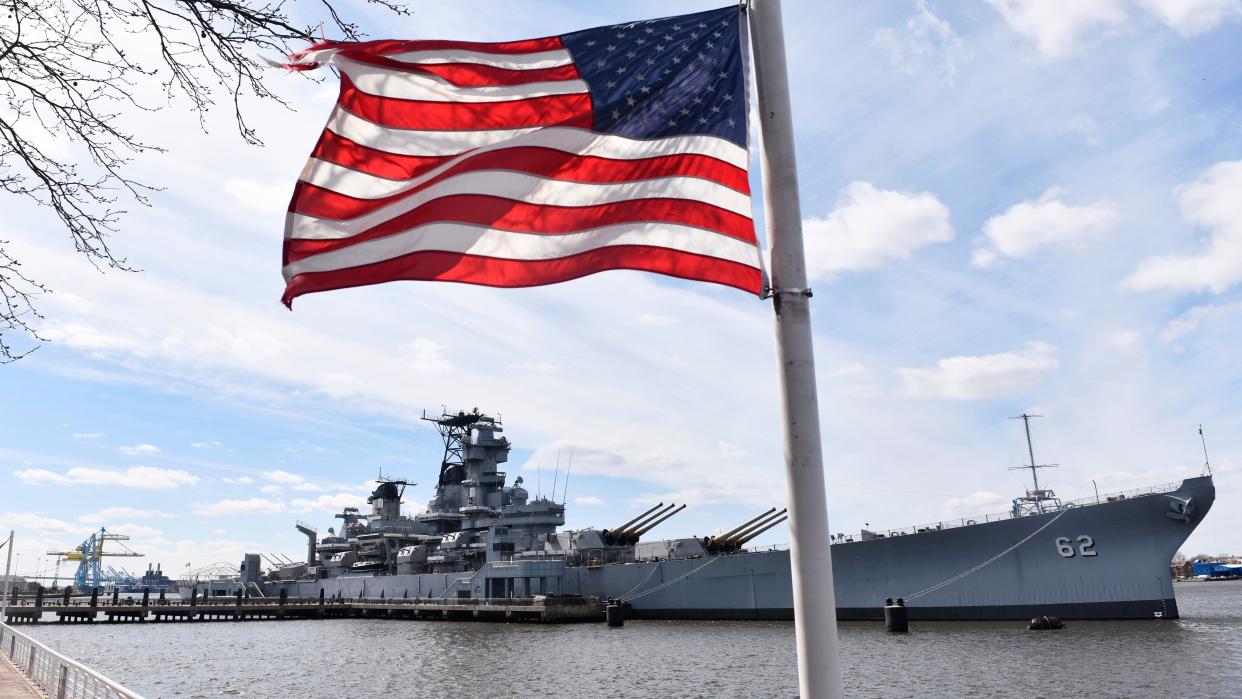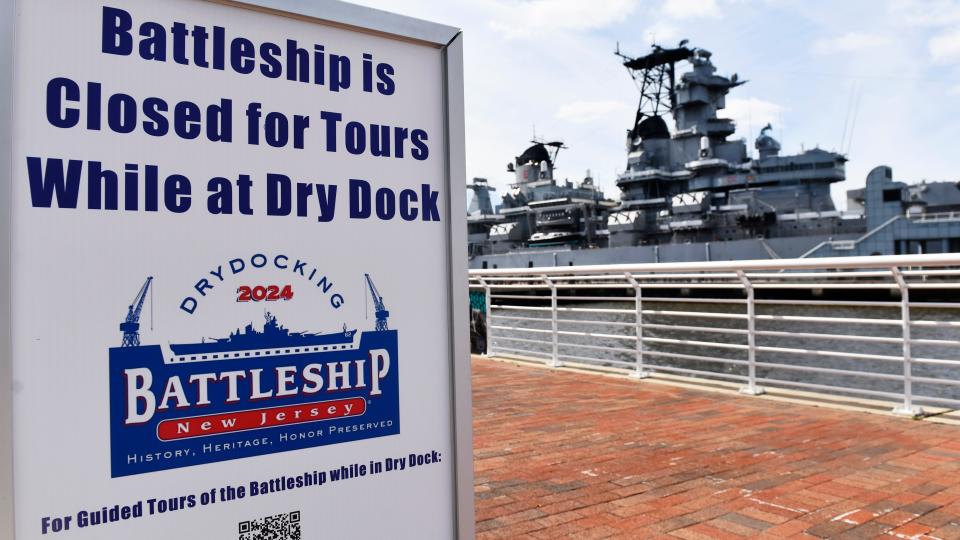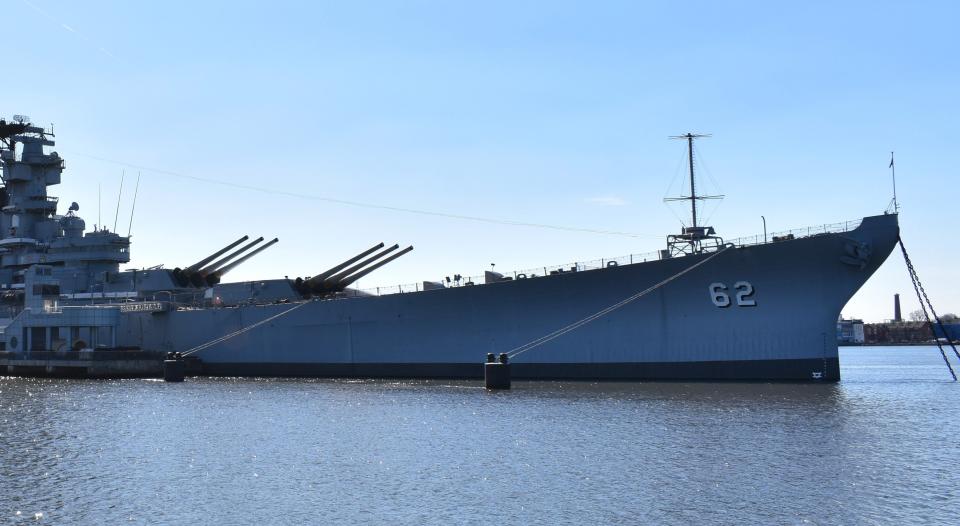What the battleship means for Camden, and how it ended up here

The USS New Jersey wasn't always meant to call Camden home, but just like the battleship itself, South Jersey went to war to bring it home.
"Battleship New Jersey is one of — if not the — top tourist destinations in South Jersey. This45-ton, 887-foot historic gem attracts more than 80,000 visitors to the Camdenwaterfront each year," Marshall Spevak, CEO of the Battleship New Jersey, said.
Over its two decades as a museum, the New Jersey has become an icon, visible from across the Delaware River and standing tall along the Camden Waterfront. The area will look a little different for the next few months as the ship undergoes needed repairs at the Philadelphia Naval Yard, but the maintenance work will ensure the battleship long has a home in Camden.
The long journey for the battleship ended in Camden
Built shortly after the Japanese removed themselves from the London Naval Treaty, which limited the size and speed of capital ships, the United States needed an answer to the Kongo class ships of Japan.
Thus, the USS New Jersey and her three sister ships — the Iowa, Missouri and Wisconsin — were built. The four ships were marvels of their time. At that point, most United States ships had a max speed of 22 knots and were built with the focus of ammunition and armor in mind.
Similar in design to that of the Dakota Class ships, the Navy went with firepower over armor when designing the four Iowa-class ships.
"Throughout her years of service, she was home to more than 45,000 sailors who served aboard as well as thousands from our region who built her in the late 1930s and early 1940s. Since then, she has fought in more battles than any other battleship in history." Spevak said.
The USS New Jersey was built in the Philadelphia Navy Yard, launched in 1942 and soon after commissioned for battle in 1943. The USS New Jersey, alongside her sister ships, saw battles from WWII up until the Gulf War when it was decommissioned.
The old girl, however, still had another battle to be fought — this one would be closer to home.
North and South Jersey battle for the battleship New Jersey
Though the waterfront area would look a lot different without the New Jersey docked there, the battleship wasn’t originally meant to live out retirement so close to her birthplace.

"When the Navy announced in the late 90s that the battleship would be open for a donation, New Jersey jumped at the chance. Two competing applications were submitted: one to bring the ship to Bayonne; the other to Camden." Spevak said.
It was a long battle between the USS New Jersey Battleship Commission of North Jersey and the Home Port Alliance of the Battleship New Jersey of South Jersey. South Jersey began receiving support from states like Delaware and Pennsylvania.
"Ultimately, thanks to the incredible group of individuals that formed the Home Port Alliance, the Navy awarded the Battleship to Camden. Haddonfield’s own Capt. David McGuigan (USN, Ret.) wrote the over 2,000-page application with the bipartisan support of founding trustees like John Matheussen, Patricia Egan Jones, Donald Norcross, Rear Admiral Thomas Seigenthaler (USN, Ret.), and so many more." Spevak said.
The USS New Jersey had one more trek
Before finding her home on the Camden Waterfront, the New Jersey had to make a trek from Washington State.
New Jersey also had to pay for the USS Iowa to be transported from Rhode Island to California to replace her sister ship. As Bremerton waved goodbye to the New Jersey with veterans and New Jersey's Governor Christie Todd Whitman, she was on her way home to the waters she was traversed when she was built.
When the USS New Jersey returned to the Delaware River in 2000, she was greeted by 25,000 people and towed by one of the very tugboats that towed her in 1942.
On September 28th, 2001, after receiving repairs and restoration, the USS New Jersey finally slid into her home on the Camden Waterfront.
How did the battleship impact Camden?
Being on the Camden waterfront, the New Jersey is vital to Camden's tourism draw.
“This landmark is routinely ranked as one of New Jersey’s top museums as well as one of the best things to do while visiting Philadelphia thus contributing greatly to the growth of our local economy,” Camden County Commissioner Melinda Kane explained. “The Battleship drives tourism to the area and opens the door for visitors to see all the wonderful things that we have to offer here in Camden County and along the waterfront in Camden.”
Kane said other waterfront attractions — like the Adventure Aquarium, Wiggins Waterfront Park and nearby businesses — benefit from the New Jersey’s draw.
"The battleship attracts visitors to the area and its impact on the economy and tourism industry has been invaluable.” Kane said.
Much like her many turns leading the charge as a Navy flagship, Spevak says the USS New Jersey "has led a cultural and economic revitalization of the Camden waterfront, drawing crowds of locals, boosting tourism from across the country and even the world, and encouraging further investment. All of which help to inspire a growing sense that the city is again vibrant and on the move."

Nick Butler is an impact reporter for the Courier Post, the Daily Journal and the Burlington County Times covering community news in South Jersey. Have any tips or stories? Reach out to NButler@Gannett.com. Subscribe to stay in the loop.
This article originally appeared on Cherry Hill Courier-Post: How the battleship New Jersey took her home on the Camden waterfront

